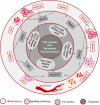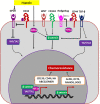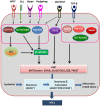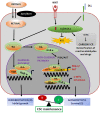Reporters of Cancer Stem Cells as a Tool for Drug Discovery
- PMID: 33968778
- PMCID: PMC8100607
- DOI: 10.3389/fonc.2021.669250
Reporters of Cancer Stem Cells as a Tool for Drug Discovery
Abstract
In view of the importance of cancer stem cells (CSCs) in chemoresistance, metastasis and recurrence, the biology of CSCs were explored in detail. Based on that, several modalities were proposed to target them. In spite of the several clinical trials, a successful CSC-targeting drug is yet to be identified. The number of molecules screened and entered for clinical trial for CSC-targeting is comparatively low, compared to other drugs. The bottle neck is the lack of a high-throughput adaptable screening strategy for CSCs. This review is aimed to identify suitable reporters for CSCs that can be used to identify the heterogeneous CSC populations, including quiescent CSCs, proliferative CSCs, drug resistant CSCs and metastatic CSCs. Analysis of the tumor microenvironment regulating CSCs revealed that the factors in CSC-niche activates effector molecules that function as CSC markers, including pluripotency markers, CD133, ABCG2 and ALDH1A1. Among these factors OCT4, SOX2, NANOG, ABCG2 and ALDH1A1 are ideal for making reporters for CSCs. The pluripotency molecules, like OCT4, SOX2 and NANOG, regulate self-renewal, chemoresistance and metastasis. ABCG2 is a known regulator of drug resistance while ALDH1A1 modulates self-renewal, chemoresistance and metastasis. Considering the heterogeneity of CSCs, including a quiescent population and a proliferative population with metastatic ability, we propose the use of a combination of reporters. A dual reporter consisting of a pluripotency marker and a marker like ALDH1A1 will be useful in screening drugs that target CSCs.
Keywords: cancer stem cells; drug resistant CSCs; drug screening and discovery; fluorescent reporters; metastasis initiating cells.
Copyright © 2021 Mohan, Raj R., Mohan, K. P. and Thomas Maliekal.
Conflict of interest statement
The authors declare that the research was conducted in the absence of any commercial or financial relationships that could be construed as a potential conflict of interest.
Figures





Similar articles
-
Markers and Reporters to Reveal the Hierarchy in Heterogeneous Cancer Stem Cells.Front Cell Dev Biol. 2021 Jun 3;9:668851. doi: 10.3389/fcell.2021.668851. eCollection 2021. Front Cell Dev Biol. 2021. PMID: 34150761 Free PMC article. Review.
-
Glutathione metabolism is essential for self-renewal and chemoresistance of pancreatic cancer stem cells.World J Stem Cells. 2020 Nov 26;12(11):1410-1428. doi: 10.4252/wjsc.v12.i11.1410. World J Stem Cells. 2020. PMID: 33312407 Free PMC article.
-
A novel reporter construct for screening small molecule inhibitors that specifically target self-renewing cancer cells.Exp Cell Res. 2019 Oct 15;383(2):111551. doi: 10.1016/j.yexcr.2019.111551. Epub 2019 Aug 8. Exp Cell Res. 2019. PMID: 31401066
-
Resistance to Cell Death and Its Modulation in Cancer Stem Cells.Crit Rev Oncog. 2016;21(3-4):203-219. doi: 10.1615/CritRevOncog.2016016976. Crit Rev Oncog. 2016. PMID: 27915972 Free PMC article. Review.
-
Development of a Fluorescent Reporter System to Delineate Cancer Stem Cells in Triple-Negative Breast Cancer.Stem Cells. 2015 Jul;33(7):2114-2125. doi: 10.1002/stem.2021. Epub 2015 May 15. Stem Cells. 2015. PMID: 25827713 Free PMC article.
Cited by
-
TWIST1 activates cancer stem cell marker genes to promote epithelial-mesenchymal transition and tumorigenesis in esophageal squamous cell carcinoma.BMC Cancer. 2022 Dec 6;22(1):1272. doi: 10.1186/s12885-022-10252-9. BMC Cancer. 2022. PMID: 36474162 Free PMC article.
-
Lycium barbarum polysaccharide reverses drug resistance in oxaliplatin-resistant colon cancer cells by inhibiting PI3K/AKT-dependent phosphomannose isomerase.Front Pharmacol. 2024 Mar 21;15:1367747. doi: 10.3389/fphar.2024.1367747. eCollection 2024. Front Pharmacol. 2024. PMID: 38576495 Free PMC article.
-
Sulforaphane: An emergent anti-cancer stem cell agent.Front Oncol. 2023 Jan 23;13:1089115. doi: 10.3389/fonc.2023.1089115. eCollection 2023. Front Oncol. 2023. PMID: 36776295 Free PMC article. Review.
-
A Comprehensive Analysis of the Effects of Key Mitophagy Genes on the Progression and Prognosis of Lung Adenocarcinoma.Cancers (Basel). 2022 Dec 22;15(1):57. doi: 10.3390/cancers15010057. Cancers (Basel). 2022. PMID: 36612054 Free PMC article.
-
Cationic Liposomes Carrying HPV16 E6-siRNA Inhibit the Proliferation, Migration, and Invasion of Cervical Cancer Cells.Pharmaceutics. 2024 Jun 29;16(7):880. doi: 10.3390/pharmaceutics16070880. Pharmaceutics. 2024. PMID: 39065577 Free PMC article.
References
Publication types
LinkOut - more resources
Full Text Sources
Other Literature Sources
Research Materials
Miscellaneous

